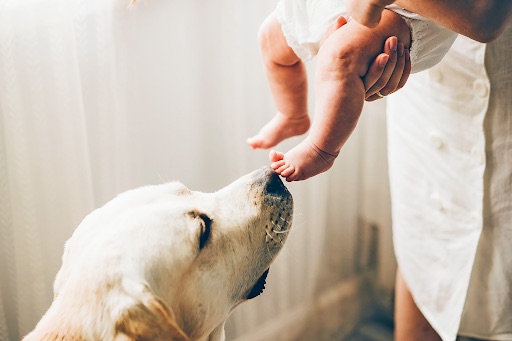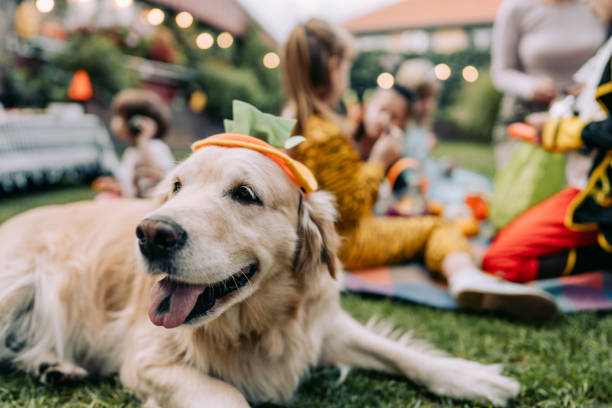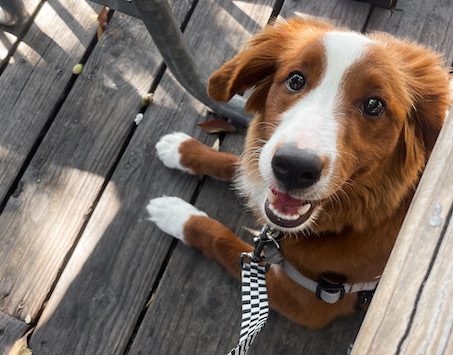Are you expecting a new addition to the family and want to start preparing your puppy or dog before the little one arrives? We are here to help! It is never too early to start pre-baby training for your dog. When you bring your baby home, we want your dog to be comfortable with all things baby, so you can relax and be confident in your dog’s behavior around the newborn. This being said, post-baby training is equally as important as training before your baby comes home. In this blog, we will go over some helpful exercises and strategies you can utilize to acclimate your dog before and after your new bundle of joy arrives.
Classical Conditioning
Before we dive into training, we first want to address what will allow your dog to have the most success throughout the exercises and strategies we are going to cover. At Beyond the Dog, we utilize classical conditioning which creates a positive association with certain stimuli by using something your dog enjoys, which can be food, toys, treats, etc. We call this process “pairing.”
Since we are pairing a new situation with something positive (i.e. food) this will allow your dog to acclimate easily to everything baby-related. We do this by using a specific marker word (e.g. “yes,” “good”) to capitalize on the exact moment a noise or action occurs. This will help your dog to remain relaxed and comfortable when that same stimulus happens again in the future.
If you also have kids ages 5 and older check out our blog on “How to Include Kids in Puppy Training“.
Pre-Baby Training
Are you expecting a baby in the near future and want to hit the ground running with pre-baby training for your dog? Acclimating your dog to loud noises and baby equipment are great ways to prepare them for the newest arrival to the family.
YouTube videos
An easy and effective way to get your dog comfortable with all of your baby’s noises is to play videos of these actions at least once a day or a few times a week leading up to the baby’s arrival. The more practice and exposure your dog gets before the baby comes home, the more comfortable they will be once the baby arrives. While the videos are being played, take note of your dog’s body language and initiate the pairing process. Do they tilt their head, tuck their tail, curiously look at the phone, etc? These are all behaviors where we recommend using your marker word and feeding your dog. Note – this isn’t a one-and-done exercise. The first few times you play the videos, feeding your dog at a high rate will be necessary. Every single time your dog acknowledges any crying, screaming, or cooing, use your marker word and feed them; it might be every few seconds at first. Over time, as you continue to play the videos, your dog will start to become accustomed to the sounds. You should notice they react or acknowledge the sounds less often or ignore them altogether. At that point, you can praise or feed them for their calm behavior. This will encourage your dog to be more comfortable and relaxed around your baby when they come home.
Equipment

Another way to prepare your dog for pre-baby arrival is to get out all of the equipment associated with your new baby early. Set up your strollers, swings, crib, etc. We want your dog to be comfortable around all of these new pieces of equipment, especially since they will be around for the first few months to years of your newborn’s life. At first, these pieces of equipment can potentially be big, bulky, and scary for your dog, but it doesn’t have to be after you practice some pairing exercises! After all of the equipment has been brought out, start setting everything up and breaking it down multiple times per week.
As you do this, keep an eye on your dog, use your word and feed them every time they acknowledge the equipment by looking at it, sniffing it, or reacting to a sound made by it. Again these pieces of equipment will be something new for your dog and the first few times you do this, a high rate of feeding will be necessary.
Similarly, if you plan on taking your newborn for a walk in a stroller and bringing your dog along, we do recommend going for walks with the stroller before the baby arrives. It may feel silly walking a stroller around without a baby in it, but trust us, it is worth it! Throughout the walk use your marker word and feed your dog every few steps to get your dog used to the way the stroller moves and the noises it makes. Pairing new movements, noises, and actions will set your dog up for success when the baby arrives. Reinforcing walking calmly and without pulling next to you and the stroller will also make walking in the future with your baby so much easier!
Post-Baby Training
Pairing, pairing, pairing! After your new bundle of joy arrives home, the most effective exercise you can do to acclimate your dog to your newborn is pair – everything! When the baby comes home, making all of the interactions between the newborn and your dog as positive as possible will be the most beneficial for your newborn and dog as they grow together.
Pairing
After the baby comes home, pairing everything about your newborn (e.g. movements, noises, smells) is critical to the training process. New parents can be nervous about their dog getting too close to their newborn; it is good to be cautious and take everything slowly but to still allow those interactions to happen!
When introducing your dog to your newborn, we recommend following these steps:
- Have a baggie of treats on hand.
- Put a leash on your dog, hold onto the leash, and slowly approach the baby while someone else holds them.
- If your dog is curiously sniffing and walking forward, continue walking up to the baby. Use your marker word and feed your dog if they sniff or make any contact with the newborn.
- After feeding your dog a treat, step in between the newborn and dog, turn them around and approach the baby again.
- Repeat this exercise 15-20 times the first few days your baby comes home.
This will teach your dog to approach the newborn politely and reinforce calm behavior in their presence. If you notice the dog doesn’t approach the baby with a loose or wiggly body, do not advance toward the baby. If you notice your dog’s ears are back, their tail is tucked, or their body is stiff, continue to keep a safe distance away while periodically offering food and treats until they become more comfortable at that distance. They may take a few days or even a week or so to get used to the new baby, and that’s okay! Aside from doing approaches, feeding your dog when your baby cries, and during bath time, feeding time, and diaper changes, will promote calm, relaxed behavior in your dog around your newborn.
If you want more information about acclimating your dog to a newborn baby, check out our Private in-Home training sessions to learn more!




